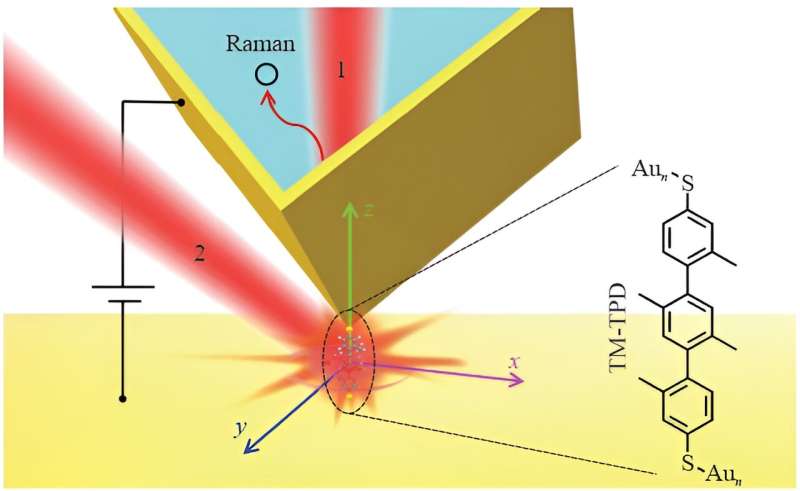This article has been reviewed according to Science X's editorial process and policies. Editors have highlighted the following attributes while ensuring the content's credibility:
fact-checked
trusted source
proofread
An optical and electrically driven single-molecule Raman switch

The role of molecular junctions in nanoelectronics is most often associated with electronic transport; however, their precise characterization hinders their widespread development. Recently, most research has focused on investigating molecular junctions based on electronic characterization.
In addition to applied voltage, light can influence the molecular state and characterizes molecular states complementarily. The interaction of light with molecular junctions is a supplementary factor for the development of molecular switches. However, most classical optical spectroscopy methods are limited by diffraction, which makes it difficult to characterize nanoscale systems with ultrahigh spatial resolution.
Near-field-enhanced techniques based on local surface plasmon (LSP) can break the diffraction limit and provide an excellent solution for ultramicroscopy. Such near-field-enhanced techniques provide highly accurate methods for nano areas, such as coherent manipulation, processing, and measurement techniques for tunneling currents in nano electronic devices.
In a new paper published in Light: Advanced Manufacturing, a team of scientists, led by Doctor Hai Bi from Jihua Laboratory, China, and co-workers have presented a single-molecular Raman switch, which is controlled not only by an applied voltage, but also by optical inputs with different directions.
In this study, the combined effect of the near-field optical angular momentum and the bias voltage on the Raman response of a single molecular junction, creating a molecular switch, was investigated. Using a homemade molecular junction spectroscopy (MJS) platform, optical and electrically driven conformational switching in the covalently linked metal–molecule–metal junctions of TM-TPD was characterized.
The non-π-conjugated molecular 'wire' of TM-TPD electrically connects the gold-coated tip of a tunneling microscope to a gold substrate. Previously, a TM-TPD molecular junction was used to confirm a prior observation that the Raman activity of the molecule can be turned ON and OFF using the biased voltage because of the molecular conjugation during charge transport through molecular orbitals. In this study, it was further demonstrated that the molecular switch can be manipulated using an optical input.
The effects of both the polarization of light and the subsequent symmetry properties of the electromagnetic near field were investigated and used to control the switching behavior. This change in the Raman response of the junction is associated with a modification of the conformation of the molecule. By changing both the illumination side and the voltage applied to the junction, the Raman intensity can be turned ON and OFF with a difference of nearly five orders of magnitude between the two states.
It was shown that conformational molecular junctions can be controlled not only by the voltage applied to a single-molecule junction but also by the optical angular momentum in the near field, which is enhanced by the plasmon gap mode in the junction. A high bias voltage results in an electron density rearrangement of the molecular junction, which activates the Raman mode.
This Raman mode is enhanced by planarization and increased π-conjugation of the TM-TPD molecule. The angular momentum of light causes a z-axis torque when the distribution of the electromagnetic field is asymmetric. This makes it possible to change the conformation of the TM-TPD, destroys the transport electron density rearrangement, and finally suppresses the Raman mode. These studies made it possible to identify experimentally that the optical angular momentum is a driving force for molecular switching.
More precisely, it was found that the angular momentum excitation has a very close link with the symmetry of the near-field system. This study opens up new avenues for research on molecular logic and optical angular momentum in the near-field regime. The possibility of addressing physicochemical phenomena with a single-molecule resolution shown in this study serves as a departure point for a new generation of nanomechanical studies using MJS setups.
Technologically, these investigations demonstrated single-molecule monitoring and manipulation with excellent control, opening new avenues for multi-logic single-molecule computing.
More information: Jianchen Zi et al, Effect of near-field optical angular momentum on molecular junctions, Light: Advanced Manufacturing (2023). DOI: 10.37188/lam.2023.034
Provided by Chinese Academy of Sciences




















